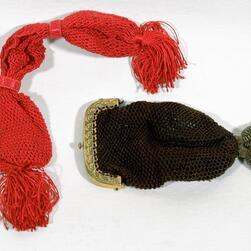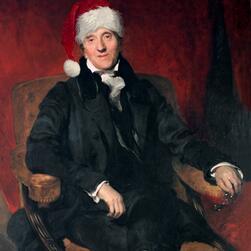Museum Archivist and author of At Home with the Soanes Sue Palmer reveals how Soane and his wife celebrated the festive period.
Christmas as we know it today is very much a construct of the Victorians, but several of the customs with which they are credited as introducing actually arrived earlier, with Princess Charlotte of Mecklenburg- Strelitz when she married George III in 1761. She is thought to have introduced the idea of the Christmas tree, although it does not seem to have caught on in any big way until Victoria and Albert adopted the custom at Windsor. Long before that there had been a tradition of decorating houses with holly and ivy and other evergreens at Christmas time, and of feasting and merry-making. Traditionally, presents were exchanged at New Year and the custom of giving them at Christmas is again said to have been due to Princess Charlotte. The Christmas card was not invented until 1843.
There was not the long lead up to Christmas that there is now. Richard Rush, Envoy Extraordinary and Minister Plenipotentiary from the United States from 1817-1825, writes of 24 December 1817: ‘Being the day before Christmas there was more display in the shops than usual. I did not get back until candle-light. The whole scene began to be illuminated. Altogether what a scene it was! The shops in the Strand and elsewhere, where every conceivable article lay before you; and all made in England…’
In common with many others of his time, Soane always seems to have worked on Christmas Day – writing letters, settling accounts or drawing plans. However, his Office did shut down and his architectural pupils had Christmas Day and Boxing Day off, and sometimes also 27 December. Mrs Soane often visited the children at the nearby Foundling Hospital on Christmas Day.
Then at 4.00 pm they sat down to dinner, usually with quite a few guests. In 1810 Mrs Soane records in her diary: ‘Wet day – dined here Foxhall 5, Kinderley 2, Trenchman 2, Britton 2. Smith 1, Buxton 1. F. Foxhall and Miss Smith slept here’. The following year the party included ‘Mr Braham and Madame Storace’. John Braham and Nancy Storace were well-known singers (Nancy was the first to sing the role of Mozart’s Susanna) so I am sure there must have been some musical entertainment after dinner, upstairs in the Drawing Rooms.
Then as now turkey featured prominently on the menu, together with fowls, pheasants, hams and hares. Oysters were a traditional start to Christmas dinner, as is still the case in the South of France today, and Mrs Soane’s cookery book, The London Art of Cookery by John Farley, 1783, even features a recipe for oyster sauce for turkey!
Quantities of suet appear in the Soanes’ Cook’s account books at this time of year, for the making of plum pudding (plums being dried plums, that it to say prunes). The pudding would have been eaten as part of one of the first two savoury courses, as an accompaniment to meat, rather than a dessert as now. Christmas, or minced pies were also much eaten for the two or three days around Christmas. Minced meat actually included meat – once again the mixture of sweet and savoury. The Soanes patronised John Jordan, a grocer and tea and coffee dealer at 302 High Holborn, and the surviving domestic records always include a Christmas order in the second or third week of December, for currants, raisins, peel, nutmeg, mace, ginger, cloves and moist sugar.
A variety of wines were also consumed, including champagne, which Soane purchased from Ruinart. Nor were the servants forgotten – punch and porter was purchased for them.
Sadly we have little evidence of the Christmas presents that were exchanged in the Soane household. On 14 January 1818 Soane records that he gave his housekeeper ‘a pocket Almanack [a sort of diary], my usual present to my dear Eliza’ [his wife, who had died in November 1815]. However, one Christmas present survives: two net purses made for Soane by his grand-daughters, Maria and Elizabeth, and given to him on 24 December 1829. Over a century and a half later when cataloguing Soane’s papers I came across them, as bright as the day they were made, still wrapped in the letter that had accompanied them.
Christmas boxes were also expected by servants and tradesmen, and every year Soane gave 10/6 to the Beadle and Watchmen of Lincoln’s Inn Fields, 1/- to the Turncock [who looked after the water supply], 2/6 to the General Postman and 2/6 to the Tuppeny Postman. It was left to the Cook to give 1/- each to the Dustman, the Sweep and the Newspaper boy.
When Soane went to Chertsey (where he had family) on 26 December 1815 he gave the Coachman 3/- for his Christmas dinner. Similarly on 30 December 1806 he records: ‘At the Bank [of England, where he was Architect and Surveyor], gave parlour door keepers as usual £2.2.0 and Schackell at the gate £0.7.0.
At Home with the Soanes by Sue Palmer is available from the Museum shop or online.


